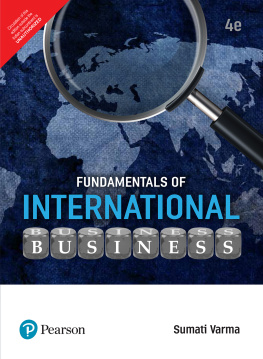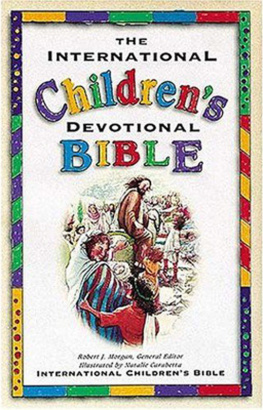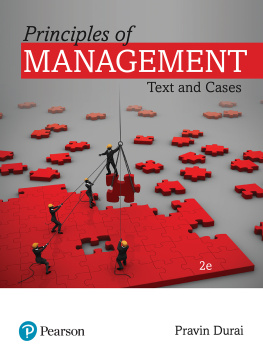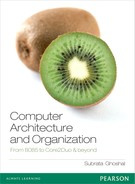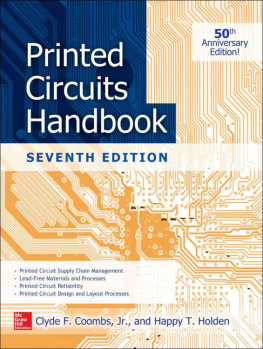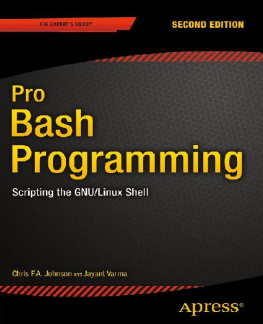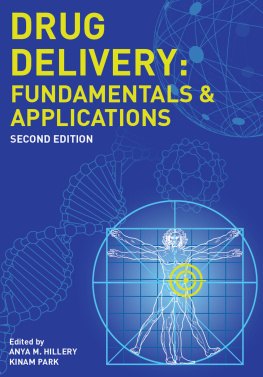About Pearson
Pearson is the worlds learning company, with a presence across 70 countries worldwide. Our unique insights and world-class expertise comes from a long history of working closely with renowned teachers, authors and thought leaders, as a result of which, we have emerged as the preferred choice for millions of teachers and learners across the world.
We believe learning opens up opportunities, creates fulfilling careers and hence better lives. We hence collaborate with the best of minds to deliver you class-leading products, spread across the Higher Education and K12 spectrum.
Superior learning experience and improved outcomes are at the heart of everything we do. This product is the result of one such effort.
Your feedback plays a critical role in the evolution of our products and you can contact us at reachus@pearson.com. We look forward to it.
FUNDAMENTALS OF INTERNATIONAL BUSINESS
FOURTH EDITION
Sumati Varma
Department of Commerce
Sri Aurobindo College (Evening)
University of Delhi
Dedicated to my parents, friends, teachers, and the Almighty
B. Com.: Semester VI
Paper BC 6.2 (a): INTERNATIONAL BUSINESS
Duration: 3 hours
Objective: The objective of the course is to expose students to the concept, importance and dynamics of international business and Indias involvement with global business operations. The course also discusses theoretical foundations of international business to the extent these are relevant to understand the mechanics of global business operations and development.
Unit I
- Introduction to International Business: Globalization and its growing importance in world economy; Impact of globalization; International business contrasted with domestic business - complexities of international business; Internationalization stages and orientations. Modes of entry into international business.
- International Business Environment: National and foreign environments and their componentsPhysical, economic, demographic, cultural and political-legal environments; Global trading environment-recent trends in world trade in goods and services; Trends in Indias foreign trade.
Unit II
- Theories of International Trade; Commercial policy instruments tariff and non-tariff measures; Balance of payment account and its components. WTOIts objectives, principles, organizational structure and functioning. An overview of other organizationsUNCTAD, World Bank and IMF.
- Regional Economic Co-operation: Forms of regional groupings; Integration efforts among countries in Furope, North America and Asia.
Unit III
- International Financial Environment: International financial system and institutions; Foreign exchange markets, spot market, spot rate quotations, bid ask spreads, trading in spot market, cross exchange rates; Forward market; Rate, long and short forward position, forward premium and discount, Arbitrage, Hedging and Speculation.
- Foreign investments: Types and flows; Foreign investment in Indian perspective.
Unit IV
- International business operations: Key issues involved in making international production, finance, marketing and human resource decisions; International business negotiations.
- Developments and Issues in International Business: Outsourcing and its potentials for India; Strategic alliances, mergers and acquisitions; Role of IT in international business; International business and ecological considerations.
B.Com. (Hons.): Semester VI
Paper: BCH-6.4 DSE Group B (d): INTERNATIONAL BUSINESS
Duration: 3 hours
Objective: The objective of the course is to expose students to the concept, importance and dynamics of international business and Indias involvement with global business operations.
Unit I
- Introduction to International Business: Globalization and its growing importance in world economy; Impact of globalization; International business contrasted with domestic businesscomplexities of international business; Internationalization Stages and Orientations. Modes of entry into international business.
- International Business Environment: National and foreign environments and their componentsPhysical, economic, demographic, cultural and political-legal environments; Global trading environment - recent trends in world trade in goods and services; Trends in Indias foreign trade.
Unit II
- International Trade -Theories of International Trade, tariff and non-tariff measures; Balance of payment account and its components.
- International and Economic Organizations: WTO, UNCTAD, World Bank and IMF.
- Regional Economic Integration: Forms of regional integration; Integration efforts among countries in Europe, North America and Asia. Cost and benefit of regional economic Integration.
Unit III
- International Financial Environment: International financial system and institutions; Foreign exchange markets, Spot market, spot rate quotations, bid-ask spreads, Trading in spot markets, Cross exchange rates; Forward Market: Forward rate, long and short forward positions, forward premium and discount. Arbitrage, hedging and speculation; Foreign investments - types and flows; Foreign investment in Indian perspective.
Unit IV
- Exchange Rate Determination: Factors affecting exchange rateRelative inflation rates, relative interest rates, relative income levels, government controls, expectations, etc. Government intervention and government influence on exchange rates. Theories of exchange ratePurchasing Power Parity. Interest Rate Parity and Fishers effect.
Unit V
- Foreign Trade promotion measures and organizations in India: Special economic zones (SEZs) and 100% export oriented units (EOUs); Measures for promoting foreign investments into and from India; Indian joint ventures and acquisitions abroad.
Brief Contents
Preface to the First Edition
International business emerged as an important academic discipline in the 1960s. The discovery of the transnational corporation led to a plethora of new issues in academic learning and research. The traditional TNC was a large gigantic global corporation which made its way across the globe in incremental steps of foreign commitment and riskbeginning with trade in its geographical proximity and then moving on to more advanced modes of foreign market entry.
Some of the issues in international business pertained to: Why did firms run the risks of internationalizing? What were the sources of competitive advantage for TNCs over their domestic rivals? Were there distinctive patterns in the way that firms internationalized, and did these differ according to the national origins of TNCs? Such were the big questions that launched and sustained this field of study during its first few decades.

